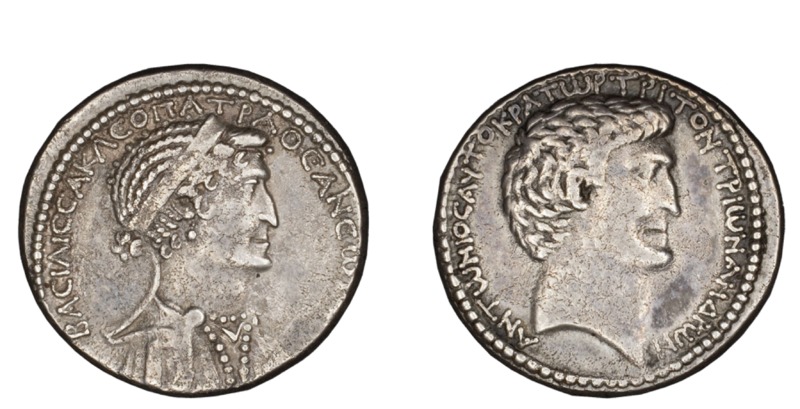Chicago Coin of Antony and Cleopatra
Title
Date
Artist or Workshop
Materials
Height of the work
Provenience
Current Location
Sitter Biography
Description and Significance
Description: This silver tetradrachm portrays the queen of Egypt, Cleopatra VII, and her lover, Mark Antony, who exerted control over most of the Roman Eastern Mediterranean. On the obverse of the coin, Cleopatra is featured, in profile, and facing to the right. Around the circumference of the coin, running from her left shoulder to the height of her mouth, there is an inscription that reads ΒΑCIΛICCA ΚΛΕΟΠΑΤΡΑ ΘΕΑ ΝΕΩ(ΤΕΡΑ), or "Queen Cleopatra, the Younger God," above which runs a circular pattern of dots which notes the edge of the stamp used to press the coin into shape. Cleopatra has braided hair: she has four braids of hair curving around the back of her head, which ends in a small braided bun at the end of her diadem, which is portrayed as a simple band. She has curls of hair running from her neck to the top of her head, on which rests a thick curl of hair, under which one wisp of hair curls back towards her forehead. She is also wearing a circular pearl earring, and a necklace which features three lines of pearls: one across the front of her neck, which is bounded on both ends by larger pearls, and two lines of pearls which extend down her dress towards the end of the coin and which curve gently inward. These three lines of pearls form a triangle, in which a small ornamentation in the shape of a "v" rests. Cleopatra is also wearing a dress of some type. Mark Antony, who is featured on the reverse side of the coin, and Cleopatra share many physical characteristics as portrayed on this coin. They both have a long, straight, and cylindrical neck, and they both have a pronounced chin, giving both rulers a small under bite, that extends as far as the tip of their nose, which is flat and hooks down in a straight line, not extending very far from their faces. They have a brow that extends very slightly past their eyes, as well. Their heads are also egg-shaped: the back of their skulls are elongated. Both figures also have an expressionless countenance, evidenced by their blank eyes and inexpressive lips, which seem to connote feelings of respectability and austerity. Mark Antony's portrait on the reverse of the coin, unlike Cleopatra's portrait, does not include his shoulders or the upper portion of his torso; it only features his neck and head. An inscription, ΑΝΤΩΟΝΟC ΑΥΤΟΚΡΑΤΩΡ ΤΡΙΤΟΝ ΤΡΙΩΝ ΑΝΔΡΩΝ, "Antonius, autokrator, third of the triumvirate," runs around the circumference of the reverse side from the back of Antony's neck to the front, and is likewise bounded with a circle of dots. Antony's hair is much simpler than Cleopatra's: it is formed by short locks of hair that point away from the crown of his skull and toward his face. His hair, which appears to be rather thick, reaches from the height of his chin on the back of his head, toward his uncovered ear, and reaches his forehead, with his locks curling to the right, and lifting very gently off of his head.
Significance: This coin is both an example of and a deviation from the Hellenistic numismatic tradition. A common trend throughout portraiture in the Ancient Mediterranean was to portray kings and queens, or husbands and wives, with similar characteristics; for example, both Menkaure and his queen share similar facial characteristics. This trend continues on Ptolemaic coins, where, for example, Ptolemy II of Egypt appears with his wife Arsinoe II in a jugate portrait, and they have a similar long nose and protruding chin. This concept of husband and wife sharing physical characteristics is meant to connote a togetherness and oneness between the two individuals. Thus, in this tetracrachm, Mark Antony and Cleopatra are understood to be two members of one political union, who are working in conjunction as both leaders and as lovers. However, one important difference separates this coin from the traditional Hellenistic canon. Usually, as evidenced by the jugate coins of the earlier Ptolemies, the man takes the leading role in the portraiture; he appears in front of his wife, and his physical characteristics are superimposed on her. However, on this coin, there is a mixture of both of these ideas. Cleopatra is represented with many of Mark Antony's facial characteristics, but she appears on the obverse on the coin, while Mark Antony appears on the reverse. This reversal of position is indicative of Cleopatra's power and influence in Egypt. Similarly, because coins were a means by which information could be disseminated in the Ancient Mediterranean, this coin could both be used by Cleopatra to indicate her influence in Egypt and the Eastern Mediterranean, but could also be used by Octavian to show his countrymen what he perceived as the declining morality of Mark Antony, and his increasing disloyalty to the Roman state. This sentiment could also be mirrored by the choice to have the coins inscribed in Greek, the primary language of the Eastern Mediterranean and of Ptolemaic Egypt, rather than the Latin of Rome.
References
Kleiner, Diana E. E. Cleopatra and Rome. Harvard University Press, May 2009. pp. 131-134.
Kroll, John H. The Emergence of Ruler Portraiture on Early Hellenistic Coins: The Importance of Being Divine. Early Hellenistic Portraiture: Image, Style, Context, Peter Schultz, ed. 2014. pp. 113-117.
http://www.artic.edu/aic/collections/artwork/194522
Contributor
Citation
Item Relations
This item has no relations.

